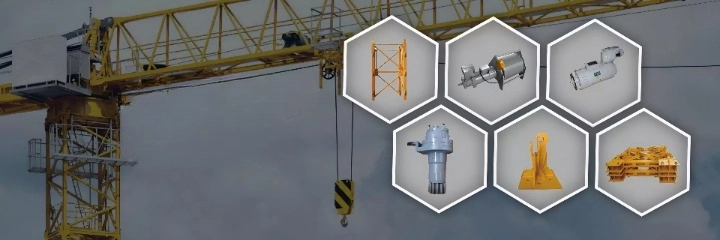In construction, your tower crane is not just a piece of equipment. It’s your lifeline for lifting, moving, and building efficiently. But here’s the problem many contractors and equipment managers face:
❌ Frequent breakdowns
❌ Unplanned repairs
❌ Expensive downtime
If you truly understand the main components of a tower crane, you control your risks.
You’ll know:
- Why failures happen
- Which spare parts to stock
- How to extend your crane’s lifespan
- How to choose high-quality compatible parts
What Are the Components of a Tower Crane?
| Component | Main Function | Common Failure Modes | Key Spare Parts |
| Mast (Tower Body) | Vertical structure support | Bolt loosening, corrosion, fatigue | Tower sections, bolts, frames |
| Slewing Ring | Crane rotation | Gear wear, bearing failure | Slewing bearing, gear segments |
| Jib | Horizontal load handling | Weld failure, deflection | Jib sections, trolley rails |
| Counter Jib | Balances load | Weight shifting, structure cracks | Counterweights, brackets |
| Hoist System | Lifts and lowers loads | Brake wear, motor overheating | Motors, brakes, wire ropes |
| Trolley System | Moves the load along the jib | Roller wear, misalignment | Trolley wheels, limit switches |
| Control System | Operates crane & safety | PLC failure, wiring issues | Inverters, PLCs, and control panels |
| Safety Devices | Protects from unsafe use | Sensor drift, wind sensor failure | Load limiters, wind sensors |
| Operator Cabin | Controls & visibility | HVAC breakdown, control faults | Joysticks, HVAC, windows |
Mast (Main Vertical Structure)
Purpose
The central tower structure holds height and stability.
Typical Problems
- Bolt loosening from constant vibration
- Weld micro-cracks from long-term load stress
- Corrosion in coastal or rainy environments
Maintenance Focus
- Quarterly torque inspections
- Annual ultrasonic weld testing
- Surface coating protection
Common Spare Parts
| Problem | Spare Part |
| Panel cracks | Mast Sections |
| Bolt fatigue | Certified Bolts |
| Foundation movement | Anchor Kits |
Slewing Ring (Rotating Bearing System)
Purpose
Enables 360-degree crane rotation under load.
Common Failures
- Tooth wear due to poor lubrication
- Bearing pitting from overload
- Backlash caused by misalignment
Maintenance Focus
- Slewing clearance measurement
- Gear inspection
- Strict lubrication schedule
Key Spare Parts
- Slewing Ring
- Pinion Gear
- Lubrication Kits
Expert Tip: Poor-quality slewing rings lead to full crane rotation failure — always demand certified products.
Jib (Main Working Arm)
Purpose
Controls horizontal load positioning.
Common Failures
- Cracked welds from heavy loads
- Excessive bending from repeated overloads
- Rail deformation causing trolley misalignment
Maintenance Focus
- Jib deflection checks
- Weld seam inspections
- Clean and inspect trolley rails
Spare Parts
- Jib Sections
- Rail Assemblies
- Sheave Wheels
Counter Jib (Balancing Arm)
Purpose
Balances the jib arm and carries motors, electrical boxes, and counterweights.
Common Failures
- Counterweight shifting during wind events
- Fatigue cracks from tower swaying
- Electrical box vibration damage
Maintenance Focus
- Secure counterweights
- Storm inspection
- Electrical mount checks
Spare Parts
- Counterweight Plates
- Electrical Mounts
- Bracing Components
Hoisting Winch
Purpose
Raises and lowers loads vertically.
Frequent Issues
- Brake pad wear
- Gearbox breakdown
- Motor overheating
- Wire rope damage
Maintenance Focus
- Brake calibration
- Motor temperature control
- Rope lifespan monitoring
Spare Parts Table
| Problem | Spare Parts |
| Brake slipping | Brake Pads |
| Gear failure | Gear Assemblies |
| Motor burnout | Hoist Motor |
| Rope fraying | Certified Wire Rope |
Safety Reminder: Replace wire ropes based on usage cycles, not just visual inspection.
Trolley System
Purpose
Moves loads along the jib horizontally.
Typical Failures
- Sheave bearing seizure
- Rail misalignment
- Sensor malfunctions
Maintenance Focus
- Sheave alignment checks
- Rail surface cleaning
- Sensor calibration
Key Spare Parts
- Trolley Carriage
- Sheave Bearings
- Proximity Sensors
Electrical Control System
Purpose
Controls all crane movements and safety features.
Common Failures
- PLC failure
- Inverter burnout
- Moisture damage
- Sensor miscalibration
Maintenance Focus
- Install cabinet dehumidifiers
- Monthly system diagnostics
- Grounding checks
Critical Spare Parts
- PLC Modules
- Frequency Inverters
- Load Sensors
- Power Boards
Safety Devices
Purpose
Prevent overloads, collisions, and unsafe conditions.
Common Failures:
- Sensor drift
- False alarms
- Load limit miscalibration
Maintenance Focus
- Monthly recalibration
- Wind sensor checks
- Load simulations
Spare Parts
- Load Limit Sensors
- Wind Speed Anemometers
- Anti-Collision Systems
- Limit Switches
Operator Cabin
Purpose
Operator comfort, visibility, and control.
Typical Problems
- A/C failures
- Joystick malfunctions
- Window cracks
Maintenance Focus
- Joystick calibration
- HVAC filter cleaning
- Window sealing checks
Spare Parts
- Joystick Controllers
- HVAC Systems
- Glass Panels
Why Do Tower Crane Components Fail So Often?
Through years of customer service, we’ve found 5 core reasons
- Incompatible spare parts: Cheap parts that don’t match OEM specs cause premature failure.
- Poor lubrication & preventive maintenance: Skipping basic care accelerates wear.
- Operator overload errors: Pushing capacity limits strains critical systems.
- Environmental stress: Heavy winds, rain, or temperature swings degrade materials.
- Lack of technical guidance: Maintenance teams need training and proper instructions.
The good news: Right parts + preventive care = longer service life and less downtime.
Quick Fault Table for Fast Troubleshooting
| Component | Typical Failure | Common Symptoms |
| Mast | Loose bolts | Shaking or vibrations |
| Slewing Ring | Gear wear | Jerky rotation |
| Jib | Cracks | Visible deflection |
| Counter Jib | Weight shift | Unstable swing |
| Hoist | Brake failure | Sudden drop issues |
| Trolley | Pulley failure | Jamming or rough travel |
| Control | PLC crash | Total shutdown |
| Safety | Sensor drift | False alarms |
My Procurement Rulebook for Spare Parts
When sourcing spare parts, always prioritize
| Priority | Why It Matters |
| Compatibility | Perfect fit prevents unsafe assembly |
| Quality | Durable components last longer |
| Lead Time | Fast shipment minimizes downtime |
| Technical Support | Experts help avoid incorrect installations |
Why Many Global Contractors Trust CPTC Spare Parts
| Advantage | What You Get |
| 15+ Years Experience | Product knowledge & engineering support |
| Full Factory | Compatibility guarantee |
| Fast Delivery | 5–10 days standard |
| Global Brand Coverage | Supports major OEM models |
| Lifetime Tech Support | Always available |
| Certified Materials | Safety compliance |
| Complete Inventory | Reduced downtime |






